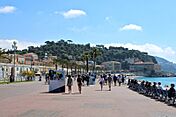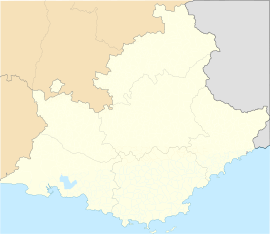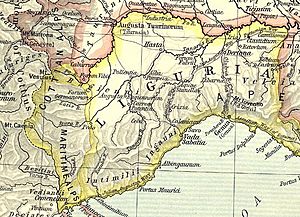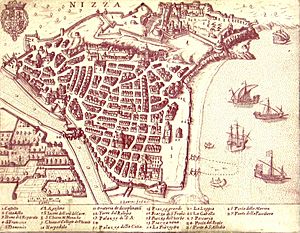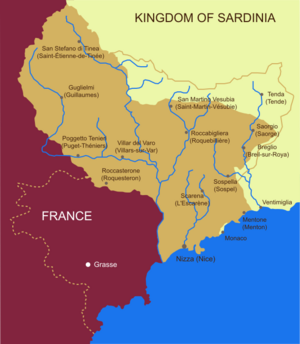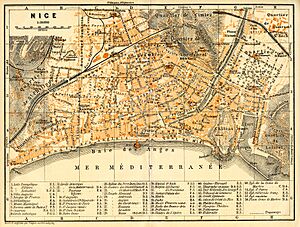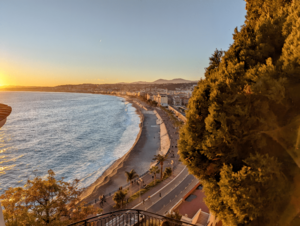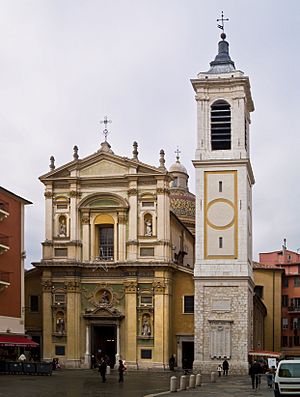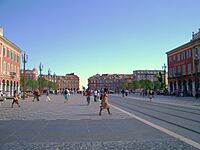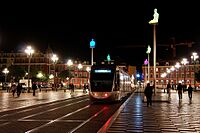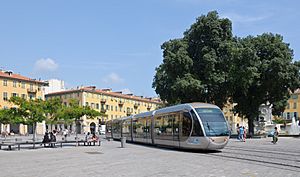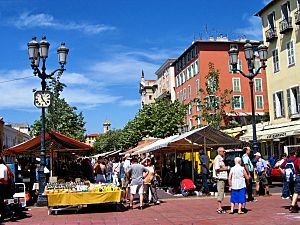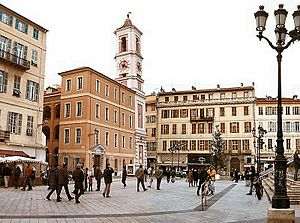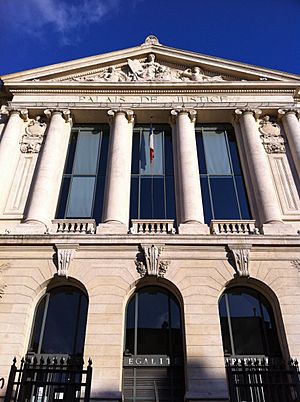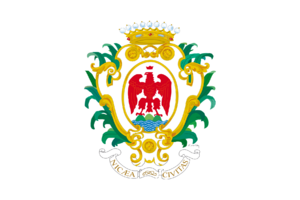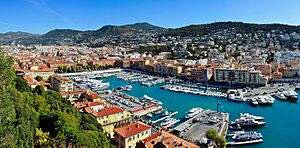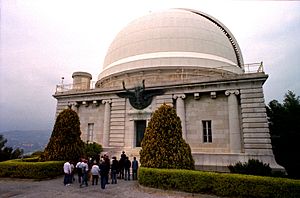Nice facts for kids
Quick facts for kids
Nice
Niça (Occitan)
|
|||
|---|---|---|---|
|
Prefecture and commune
|
|||
|
View of the City
Promenade des Anglais
Nice Cathedral
Tête Carrée
Place Masséna
Avenue Jean Médecin
Russian Church
|
|||
|
|||
| Motto(s):
Nicæa civitas fidelissima
(Latin: Nice, most loyal city) |
|||
| Country | France | ||
| Region | Provence-Alpes-Côte d'Azur | ||
| Department | Alpes-Maritimes | ||
| Arrondissement | Nice | ||
| Canton | Nice-1, 2, 3, 4, 5, 6, 7, 8, and 9 | ||
| Intercommunality | Métropole Nice Côte d'Azur | ||
| Area
1
|
71.92 km2 (27.77 sq mi) | ||
| • Urban | 743.6 km2 (287.1 sq mi) | ||
| • Metro | 2,073 km2 (800 sq mi) | ||
| Population
(2021)
|
348,085 | ||
| • Rank | 5th in France | ||
| • Density | 4,839.9/km2 (12,535.3/sq mi) | ||
| • Urban
(2018)
|
944,321 | ||
| • Urban density | 1,269.93/km2 (3,289.11/sq mi) | ||
| • Metro
(2018)
|
609,695 | ||
| • Metro density | 294.11/km2 (761.75/sq mi) | ||
| Demonym(s) | Niçois (m) Niçoise (f) |
||
| Time zone | UTC+01:00 (CET) | ||
| • Summer (DST) | UTC+02:00 (CEST) | ||
| INSEE/Postal code |
06088 /
|
||
| UNESCO World Heritage Site | |||
| Official name | Nice, Winter Resort Town of the Riviera | ||
| Criteria | Cultural: ii | ||
| Inscription | 2021 (45th Session) | ||
| 1 French Land Register data, which excludes lakes, ponds, glaciers > 1 km2 (0.386 sq mi or 247 acres) and river estuaries. | |||
Nice is a beautiful city in France. It is the main city of the Alpes-Maritimes area. Nice is on the French Riviera, which is the southeastern coast of France. It sits right by the Mediterranean Sea and at the bottom of the French Alps.
Nice is the second-largest French city on the Mediterranean coast. It is also the second-largest city in the Provence-Alpes-Côte d'Azur region. Only Marseille is bigger. Nice is about 13 kilometers from Monaco. It is also about 30 kilometers from the border with Italy. Nice's airport is a major entry point for visitors.
The city is often called Nice la Belle, which means 'Nice the Beautiful'. This is also the name of Nice's unofficial song. Long ago, people lived in the Nice area about 380,000 years ago. They even used fire! Around 350 BC, Greek settlers from Marseille started a town here. They named it Nikaia after Nike, the Greek goddess of victory.
Over time, Nice has been ruled by many different groups. Its great location and port made it a strong city for sea trade. In 1388, it became part of Savoy. Then, it was part of France from 1792 to 1815. After that, it returned to the Kingdom of Piedmont-Sardinia. Finally, it became part of France again in 1860.
In the 1700s, rich English families started visiting Nice in winter. They loved the mild weather. The city's main seaside path, the Promenade des Anglais (Walkway of the English), is named after these visitors. Even Queen Victoria and her son Edward VII spent winters here.
Famous painters like Marc Chagall and Henri Matisse loved Nice's clear air and soft light. Their art is shown in many city museums. Writers like Friedrich Nietzsche also found inspiration here.
Nice was also popular with rich Russian families. Important Russian figures are buried in Nice. Many famous people are buried in the Cimetière du Château. These include the founder of Mercedes cars, Emil Jellinek-Mercedes. Also, René Goscinny, who created the Asterix comics, is buried there.
In 2021, UNESCO named Nice a World Heritage Site. This was because of its history as a winter resort for European royalty. Nice has the second-largest number of hotels in France. It is also the second most visited city in France, with four million tourists each year. The airport is the third busiest in France. Nice is the historic capital of the County of Nice.
Contents
History of Nice
Early Beginnings
The first people lived in the Nice area about 400,000 years ago. The Terra Amata site shows early signs of fire use. It also shows houses built around 230,000 years ago. Nice was likely started around 350 BC by Greek settlers. They came from the city of Phocaea in what is now Turkey. They named it Níkaia to celebrate a victory over the local Ligurian people.
Nice quickly became a busy trading port. It had a rival Roman town called Cemenelum. The ruins of Cemenelum are now in the Cimiez area of Nice.
Medieval Times
In the 600s, Nice joined a group of towns called the Genoese League. In 729, the city fought off the Saracens. But in 859 and 880, the Saracens attacked and burned Nice. They controlled the area for much of the 900s.
During the Middle Ages, Nice was part of many wars in Italy. It was an ally of Pisa and an enemy of Genoa. Both the King of France and the Holy Roman Emperor tried to control it. But Nice managed to keep its freedom. In the 1200s and 1300s, the city was sometimes ruled by the Counts of Provence. But it always became independent again.
The old city walls protected the Old Town. The Paillon River protected one side. Castle Hill protected the east side.
Under Savoy Rule
In 1388, Nice chose to be protected by the Counts of Savoy. Nice remained part of Savoy's history until 1860.
Nice's sea power grew quickly. It could even fight off pirates. The city's defenses were made much stronger. In 1561, the Duke of Savoy made Italian the official language in Nice.
In 1543, French and Ottoman forces attacked Nice. The people fought bravely but had to give up. The city was robbed, and many people were taken captive. Sickness also hit the city in 1550 and 1580.
In 1600, French forces briefly took Nice. In 1626, the port was opened to all countries. This helped trade grow a lot.
Nice was taken by the French in 1691. It was given back to Savoy in 1696. But the French attacked again in 1705. The city's fortress was destroyed the next year.
Return to Sardinia and French Rule
The Treaty of Utrecht (1713) gave Nice back to the Duke of Savoy. He was also recognized as the King of Sicily. In the peaceful years that followed, a "new town" was built. From 1744 to 1748, the French and Spanish controlled Nice.
In 1792, French armies took over Nice. The County of Nice remained part of France until 1814. After that, it went back to the Kingdom of Piedmont-Sardinia.
Becoming Part of France (1860)
In 1860, Nice officially became part of France again. This happened after a deal between the Sardinian king and Napoleon III. The people of Nice voted on this change. Many people who preferred to be Italian moved to Italy. This event is known as the Niçard exodus.
The Italian language, which was used in schools and government, was replaced by French. The French government worked to make French culture and language stronger. Italian newspapers were banned. Many Italian family names were changed to French ones.
Some people, like Giuseppe Garibaldi who was born in Nice, did not agree with Nice becoming French. They believed Nice should be Italian. In 1871, there were protests in Nice. The French government sent soldiers to stop them.
Nice in the 1900s
In 1900, Nice started using electric trams. The tram network grew across the area. By the 1930s, buses were also added. Nice also hosted car races in the 1930s.
During World War II, Nice became a safe place for many people. This included Jewish people escaping the Nazis. In November 1942, Italian troops took over Nice. Later, German troops occupied the city. Nice was finally set free on August 30, 1944. The war caused a lot of damage, and the population decreased.
After the war, Nice grew a lot thanks to tourism and building. Many new buildings were constructed. In 2001, European leaders met in Nice to sign the Treaty of Nice. This treaty changed how the European Union worked.
In 2021, Nice was named a World Heritage Site by UNESCO. This recognized its importance as a winter resort town.
Architecture and Landmarks
The Promenade des Anglais is a famous walkway along the sea. It runs along the "Bay of the Angels" in Nice. In the 1700s, rich English visitors helped build this promenade. They loved the beautiful views. The city of Nice then made the walkway even bigger. It was first called the "English Way" by locals. Later, it became known as "La Promenade des Anglais."
The Hotel Negresco is a grand hotel on the Promenade des Anglais. It was built in 1912 by Henri Negresco.
Near the Promenade is the "Zone Piétonne," or "Pedestrian Zone." Cars are not allowed here. This makes it a great place for walking.
Old Nice is home to the Opéra de Nice. This opera house was built in the late 1800s. Today, you can enjoy many performances there.
Other interesting places to see include:
- Palais communal de Nice
- Palais de la Méditerranée
- Palais de l'agriculture
- Gare du Sud
- Jardin Albert-Ier
- Castle of Nice
- Colline du Château
Religious Buildings
Some important religious buildings in Nice are:
- Nice Cathedral
- Notre-Dame de Nice
- Russian Orthodox Cathedral, Nice
- Église Notre-Dame-du-Port de Nice
- Church of Gesù, Nice
Museums
Nice has many museums, including:
- Musée Masséna
- Musée des Beaux-Arts de Nice
- Musée Matisse
- Musée Marc Chagall
Main Squares
Place Masséna
The Place Masséna is the main square in Nice. It was divided into two parts in 1824. In 1979, a casino was taken down, making the square much larger. Now, it has red buildings that look like Italian architecture.
The square was made friendly for walkers when a new tram line was built. It has palm trees and pine trees. The Place Masséna is often used for big public events. These include concerts, the Nice Carnival parade, and Bastille Day celebrations.
The square is very close to the Promenade des Anglais and the Old Town. It is also a meeting point for several main streets.
Place Garibaldi
The Place Garibaldi is known for its special look and history. It is named after Giuseppe Garibaldi. He was a hero who helped unite Italy. He was born in Nice in 1807. The square was built in the late 1700s. It was once the main entrance to the city.
A statue of Garibaldi stands in the middle of the square. He strongly believed Nice should be part of Italy. The square is now mostly for people walking. Its buildings look like those in Turin, Italy.
It is a meeting point between the Vieux Nice (Old Town) and the city center.
Place Rossetti
This square is only for walkers and is in the heart of the Old Town. It has colorful red and yellow buildings. The cathédrale Sainte-Réparate and a fountain are in the center. Place Rossetti is a must-see spot. During the day, it is full of restaurants and ice cream shops. At night, it becomes lively with music and people.
Cours Saleya
The Cours Saleya is next to the Quai des États-Unis. In the past, rich people used to gather here. It is a very traditional square. It has a daily flower market. The Cours Saleya is also near the Palace of the Kings of Sardinia. Today, it is a popular place for fun and entertainment.
Place du Palais
The Place du Palais is where Nice's Law Courts are located. The Palais Rusca, another justice building, is also here.
The square also has the city clock. The Place du Palais is busy day and night. People often gather on the steps of the Law Courts. Concerts and other public events happen here often.
It is located between the Cours Saleya and Place Masséna.
City Government
Nice is in the Provence-Alpes-Côte d'Azur region of France. It is a commune and the main city (prefecture) of the Alpes-Maritimes area. Nice is the largest city in France that is not a regional capital. Marseille is the capital of its region. The current mayor of Nice is Christian Estrosi.
The city is divided into nine areas called cantons.
City Symbol (Coat of Arms)
The symbol of Nice, its coat of arms, first appeared around 1430. It shows a red eagle on a silver background. The eagle stands on three mountains. This design shows the power of the House of Savoy, who once ruled the area. The red and silver colors are also from the flag of Savoy. The three mountains represent the land around Nice.
Geography and Nature
Nice has two large bays. One is where Villefranche-sur-Mer sits. The main part of Nice is between the old port and the airport. It stretches along a gently curved bay. The city goes from the flat beach up into gentle hills. Mountains surround it, marking the edge of the Ligurian Alps.
Plants and Trees
Nice has plants typical of a Mediterranean area. You will see many evergreen shrubs. Trees are spread out but form thick forests in some places. Native trees include holm oak, stone pine, and arbutus. Many trees from other parts of the world grow in parks and gardens. Palms, eucalyptus, and citrus fruit trees give Nice a tropical look. You can also find trees common in cooler areas, like horse chestnut and linden.
Weather in Nice
Nice has a warm Mediterranean climate. This means it has mild winters with some rain. Summers are warm to hot, dry, and sunny. It rarely rains in summer. Temperatures are usually above 26°C but rarely go above 32°C. The highest temperature ever recorded was 37.7°C in August 2006.
Autumn starts sunny in September. It gets cloudier and rainier by October. But temperatures usually stay above 20°C until November. Winters have mild days (11 to 17°C) and cool nights (4 to 9°C). The weather can be sunny and dry or wet and rainy. Snow is very rare in Nice.
| Climate data for Nice (Nice Côte d'Azur Airport), elevation: 4 m or 13 ft, 1991–2020 normals, extremes 1942–present | |||||||||||||
|---|---|---|---|---|---|---|---|---|---|---|---|---|---|
| Month | Jan | Feb | Mar | Apr | May | Jun | Jul | Aug | Sep | Oct | Nov | Dec | Year |
| Record high °C (°F) | 22.5 (72.5) |
25.8 (78.4) |
26.1 (79.0) |
26.1 (79.0) |
31.4 (88.5) |
36.8 (98.2) |
37.0 (98.6) |
37.7 (99.9) |
33.9 (93.0) |
29.9 (85.8) |
25.4 (77.7) |
22.0 (71.6) |
37.7 (99.9) |
| Mean daily maximum °C (°F) | 13.3 (55.9) |
13.5 (56.3) |
15.4 (59.7) |
17.4 (63.3) |
21.0 (69.8) |
24.7 (76.5) |
27.5 (81.5) |
27.9 (82.2) |
24.8 (76.6) |
21.0 (69.8) |
17.0 (62.6) |
14.1 (57.4) |
19.8 (67.6) |
| Daily mean °C (°F) | 9.5 (49.1) |
9.8 (49.6) |
11.8 (53.2) |
14.1 (57.4) |
17.7 (63.9) |
21.4 (70.5) |
24.1 (75.4) |
24.5 (76.1) |
21.2 (70.2) |
17.5 (63.5) |
13.3 (55.9) |
10.3 (50.5) |
16.3 (61.3) |
| Mean daily minimum °C (°F) | 5.8 (42.4) |
6.1 (43.0) |
8.3 (46.9) |
10.8 (51.4) |
14.5 (58.1) |
18.1 (64.6) |
20.8 (69.4) |
21.1 (70.0) |
17.7 (63.9) |
14.0 (57.2) |
9.7 (49.5) |
6.6 (43.9) |
12.8 (55.0) |
| Record low °C (°F) | −7.2 (19.0) |
−5.8 (21.6) |
−5.0 (23.0) |
2.9 (37.2) |
3.7 (38.7) |
8.1 (46.6) |
11.7 (53.1) |
11.4 (52.5) |
7.6 (45.7) |
4.2 (39.6) |
0.1 (32.2) |
−2.7 (27.1) |
−7.2 (19.0) |
| Average precipitation mm (inches) | 73.5 (2.89) |
53.6 (2.11) |
51.0 (2.01) |
68.8 (2.71) |
40.3 (1.59) |
35.7 (1.41) |
13.6 (0.54) |
17.2 (0.68) |
81.0 (3.19) |
127.9 (5.04) |
138.4 (5.45) |
90.3 (3.56) |
791.3 (31.15) |
| Average precipitation days (≥ 1.0 mm) | 5.8 | 5.1 | 4.9 | 6.4 | 5.1 | 3.8 | 1.8 | 2.3 | 4.9 | 7.5 | 8.5 | 6.0 | 62.1 |
| Average snowy days | 0.3 | 0.7 | 0.0 | 0.0 | 0.0 | 0.0 | 0.0 | 0.0 | 0.0 | 0.0 | 0.0 | 0.2 | 1.1 |
| Average relative humidity (%) | 67 | 68 | 69 | 72 | 75 | 75 | 73 | 72 | 74 | 73 | 71 | 67 | 71.3 |
| Mean monthly sunshine hours | 156.7 | 166.1 | 218.0 | 229.2 | 270.9 | 309.8 | 349.3 | 323.2 | 249.8 | 191.1 | 151.5 | 145.2 | 2,760.5 |
| Average ultraviolet index | 1 | 2 | 4 | 5 | 7 | 8 | 8 | 7 | 5 | 3 | 2 | 1 | 4 |
| Source 1: Météo-France | |||||||||||||
| Source 2: Infoclimat.fr (relative humidity 1961-1990), Weather Atlas | |||||||||||||
| Climate data for Nice (Nice Côte d'Azur Airport), elevation: 4 m or 13 ft, 1961–1990 normals and extremes | |||||||||||||
|---|---|---|---|---|---|---|---|---|---|---|---|---|---|
| Month | Jan | Feb | Mar | Apr | May | Jun | Jul | Aug | Sep | Oct | Nov | Dec | Year |
| Record high °C (°F) | 19.6 (67.3) |
25.8 (78.4) |
23.8 (74.8) |
25.2 (77.4) |
30.3 (86.5) |
31.1 (88.0) |
35.7 (96.3) |
34.4 (93.9) |
33.9 (93.0) |
29.9 (85.8) |
23.8 (74.8) |
21.3 (70.3) |
35.7 (96.3) |
| Mean maximum °C (°F) | 14.7 (58.5) |
17.6 (63.7) |
16.5 (61.7) |
18.1 (64.6) |
21.8 (71.2) |
25.1 (77.2) |
28.7 (83.7) |
28.4 (83.1) |
26.4 (79.5) |
22.7 (72.9) |
17.7 (63.9) |
14.7 (58.5) |
28.7 (83.7) |
| Mean daily maximum °C (°F) | 12.6 (54.7) |
13.1 (55.6) |
14.7 (58.5) |
16.6 (61.9) |
19.7 (67.5) |
23.1 (73.6) |
26.5 (79.7) |
26.8 (80.2) |
24.3 (75.7) |
21.0 (69.8) |
16.4 (61.5) |
13.6 (56.5) |
19.0 (66.3) |
| Daily mean °C (°F) | 8.7 (47.7) |
9.4 (48.9) |
11.0 (51.8) |
13.1 (55.6) |
16.4 (61.5) |
19.8 (67.6) |
22.9 (73.2) |
23.1 (73.6) |
20.5 (68.9) |
17.0 (62.6) |
12.5 (54.5) |
9.7 (49.5) |
15.3 (59.6) |
| Mean daily minimum °C (°F) | 4.8 (40.6) |
5.8 (42.4) |
7.3 (45.1) |
9.7 (49.5) |
13.0 (55.4) |
16.3 (61.3) |
19.3 (66.7) |
19.4 (66.9) |
16.9 (62.4) |
13.3 (55.9) |
8.4 (47.1) |
5.7 (42.3) |
11.7 (53.0) |
| Mean minimum °C (°F) | 2.1 (35.8) |
2.5 (36.5) |
4.1 (39.4) |
8.1 (46.6) |
11.0 (51.8) |
14.8 (58.6) |
17.3 (63.1) |
17.0 (62.6) |
13.8 (56.8) |
8.4 (47.1) |
6.9 (44.4) |
3.2 (37.8) |
2.1 (35.8) |
| Record low °C (°F) | −7.2 (19.0) |
−5.8 (21.6) |
−5.0 (23.0) |
2.9 (37.2) |
6.6 (43.9) |
8.1 (46.6) |
10.0 (50.0) |
13.0 (55.4) |
7.6 (45.7) |
4.5 (40.1) |
0.6 (33.1) |
−2.7 (27.1) |
−7.2 (19.0) |
| Average precipitation mm (inches) | 61.3 (2.41) |
50.8 (2.00) |
66.2 (2.61) |
57.0 (2.24) |
37.4 (1.47) |
30.8 (1.21) |
6.5 (0.26) |
24.5 (0.96) |
29.5 (1.16) |
78.9 (3.11) |
91.5 (3.60) |
67.1 (2.64) |
601.5 (23.67) |
| Average precipitation days (≥ 1.0 mm) | 6.8 | 6.4 | 6.1 | 6.3 | 5.2 | 4.1 | 1.9 | 3.1 | 4.0 | 5.8 | 7.0 | 6.0 | 62.7 |
| Average snowy days | 0.7 | 0.2 | 0.1 | 0.0 | 0.0 | 0.0 | 0.0 | 0.0 | 0.0 | 0.0 | 0.1 | 0.3 | 1.4 |
| Average relative humidity (%) | 67 | 68 | 69 | 72 | 75 | 75 | 73 | 72 | 74 | 73 | 71 | 67 | 71.3 |
| Mean monthly sunshine hours | 150.3 | 151.9 | 202.3 | 226.9 | 269.8 | 295.7 | 340.4 | 306.8 | 238.7 | 205.0 | 155.5 | 150.9 | 2,694.2 |
| Percent possible sunshine | 53 | 52 | 55 | 57 | 60 | 65 | 74 | 72 | 64 | 61 | 55 | 55 | 60 |
| Source 1: NOAA | |||||||||||||
| Source 2: Infoclimat.fr (humidity) | |||||||||||||
| Climate data for Nice | |||||||||||||
|---|---|---|---|---|---|---|---|---|---|---|---|---|---|
| Month | Jan | Feb | Mar | Apr | May | Jun | Jul | Aug | Sep | Oct | Nov | Dec | Year |
| Average sea temperature °C (°F) | 13.4 (56.1) |
13.0 (55.4) |
13.4 (56.1) |
14.6 (58.3) |
18.0 (64.4) |
21.8 (71.2) |
23.1 (73.6) |
23.6 (74.5) |
22.2 (72.0) |
19.6 (67.3) |
17.4 (63.3) |
14.9 (58.8) |
17.9 (64.3) |
| Mean daily daylight hours | 9.0 | 11.0 | 12.0 | 13.0 | 15.0 | 15.0 | 15.0 | 14.0 | 12.0 | 11.0 | 10.0 | 9.0 | 12.2 |
| Source: Weather Atlas | |||||||||||||
Economy and Tourism
Nice is a major center for business and tourism. The Chambre de commerce et d'industrie Nice Côte d'Azur manages the Port of Nice. There are also several business parks in the city.
Nice has a large conference center called the Palais des Congrès Acropolis. The city also has many shopping centers. These include Nicetoile and Cap3000, which is one of the biggest malls in France.
Sophia Antipolis is a technology park near Nice. It has many companies that work with computers, electronics, and medicine. It is known as "Europe's first science and technology hub."
The Nice area has a strong economy. It is valued at over 5 billion euros.
Transportation
Port of Nice
The main port of Nice is called Lympia port. It was started in 1745. Today, it is a key port for cement in France. Fishing boats still use the port, but there are fewer professional fishermen now. Nice is the closest point in mainland France to Corsica. So, many ferries connect Nice to the island. High-speed ferries are also available.
Nice Airport
Nice Côte d'Azur Airport is the third busiest airport in France. Only two airports near Paris are busier. It is located on the Promenade des Anglais. It has two terminals. The airport also serves Monaco, which is very close. Helicopters connect Nice and Monaco. The new Tramway line 2 (T2) connects the airport to the city.
Train Travel
The main train station is Nice-Ville. High-speed TGV trains connect Nice to Paris in less than 6 hours. Local trains (TER) also run here. You can reach Marseille in 2.5 hours. Nice also has international train connections to Italy, Switzerland, and other countries.
Nice is also the start of the Chemins de Fer de Provence railway line. This line connects Nice to Digne in about 4 hours.
Tram System
Tramway de Nice started with horse-drawn trams in 1879. They became electric in 1900. By 1930, the network was 144 kilometers long. Trams were replaced by trolleybuses in the 1950s.
In 2007, a new tramway system opened in Nice. It connects the northern and eastern parts of the city through the center. Two more lines are now running. One goes from east to west, connecting to the airport and the port. A third line connects to the future TGV station.
Roads
The A8 autoroute and the Route nationale 7 are major roads that pass through Nice.
Sports and Entertainment Venues
- Stade du Ray (no longer exists)
- Allianz Riviera
- Stade Charles-Ehrmann
- Stade Marcel-Volot
- Palais Nikaïa
- Nice Jazz Festival
- Nice Carnival
Sports in Nice
- The city's main football club is OGC Nice. They play in Ligue 1, which is the top league in France.
- The Olympic Nice swimming club is also famous. Swimmers like Camille Muffat and Yannick Agnel trained there.
- Nice is the finish line for the yearly cycling race called Paris–Nice.
- The Nice Hockey Élite club plays in the top French ice hockey league.
- The Stade Niçois is a rugby club.
Population of Nice
| Historical population | ||||||||||||||||||||||||||||||||||||||||||||||||||||||||||||||||||||||||||||||||||||||||||||||||||||||||||
|---|---|---|---|---|---|---|---|---|---|---|---|---|---|---|---|---|---|---|---|---|---|---|---|---|---|---|---|---|---|---|---|---|---|---|---|---|---|---|---|---|---|---|---|---|---|---|---|---|---|---|---|---|---|---|---|---|---|---|---|---|---|---|---|---|---|---|---|---|---|---|---|---|---|---|---|---|---|---|---|---|---|---|---|---|---|---|---|---|---|---|---|---|---|---|---|---|---|---|---|---|---|---|---|---|---|---|
|
|
|||||||||||||||||||||||||||||||||||||||||||||||||||||||||||||||||||||||||||||||||||||||||||||||||||||||||
| Source: EHESS and INSEE | ||||||||||||||||||||||||||||||||||||||||||||||||||||||||||||||||||||||||||||||||||||||||||||||||||||||||||
In 2018, the urban area of Nice had 944,321 people. This makes it the seventh most populated urban area in France. The wider metropolitan area had 609,695 people. This makes it the 13th largest in France.
Since the 1970s, the number of people living in Nice has stayed about the same. Many people move to Nice, but the birth rate is lower than the death rate.
Nice Observatory
The Observatoire de Nice (Nice Observatory) is on top of Mont Gros. A banker named Raphaël Bischoffsheim started it in 1879. The famous architect Charles Garnier designed it. Gustave Eiffel, who designed the Eiffel Tower, created the main dome.
The observatory's 76-cm telescope started working in 1888. At that time, it was the largest telescope in the world.
Culture in Nice
The Terra-Amata site near Nice shows very old human settlements. The ancient Greeks founded Nice. There was also an old Roman city called Cemenelum nearby.
Since the 2nd century AD, Nice's special light has attracted many artists. These include painters and sculptors like Chagall, Matisse, and Niki de Saint Phalle. Nice has also inspired many musicians and thinkers.
Nice has many different museums:
- Musée Marc Chagall
- Musée Matisse
- Musée des Beaux-Arts
- Musée international d'Art naïf Anatole Jakovsky
- Musée Terra-Amata
- Museum of Asian Art
- Musée d'art moderne et d'art contemporain
- Museum of Natural History
- Musée Masséna
- Naval Museum
- Galerie des Ponchettes
As a vacation spot, Nice hosts many festivals all year. These include the famous Nice Carnival and the Nice Jazz Festival.
Nice has its own special culture because of its history. The local language, Niçard (Nissart), is a dialect of Occitan. Many people still speak it. Nice has strong influences from Italian and Corsican cultures.
In the past, many people moved to Nice from Italy, Spain, and Portugal. Now, people from all over the world live here. Traditions are still important. You can see them in folk music and dances like the farandole.
Since 1860, a cannon is fired at noon sharp from the Château. You can hear it almost everywhere in the city. This tradition started because a man wanted to remind people to have lunch on time!
Nice's Food
The food in Nice is similar to that of Provence and Liguria. It uses local ingredients like olive oil, anchovies, fruits, and vegetables. It also uses ingredients from far away. Ships bringing olive oil would bring other foods, like dried haddock.
Nice has about 200 local recipes. Some famous ones include:
- "Pissaladière": a tart made with onions and anchovies. It is like a type of pizza.
- Socca: a pancake made from chickpea flour.
- Farcis niçois: vegetables stuffed with breadcrumbs, meat, and herbs.
- Salade niçoise: a tomato salad with eggs, tuna or anchovies, and olives.
Local meat comes from nearby valleys, like sheep from Sisteron. Local fish like mullets and sea urchins are used a lot. There is even a saying: "fish are born in the sea and die in oil."
Examples of Nice's special foods:
Education
Nice has many schools and universities:
- Côte d'Azur University
- Institut Eurécom
- École des hautes études commerciales du nord
- École pour l'informatique et les nouvelles technologies
- Villa Arson
- ESRA film school
- Institut supérieur européen de formation par l'action
- IPAG Business School
- Supinfo
- Skema Business School
- Lycée Masséna
- Lycée Albert-Calmette
International Connections
Nice is connected to many cities around the world. These are called twin towns or sister cities.
 Alicante, Spain
Alicante, Spain Antananarivo, Madagascar
Antananarivo, Madagascar Astana, Kazakhstan
Astana, Kazakhstan Can Tho, Vietnam
Can Tho, Vietnam Cartagena, Colombia
Cartagena, Colombia Cuneo, Italy
Cuneo, Italy Edinburgh, UK
Edinburgh, UK Gdańsk, Poland
Gdańsk, Poland Hangzhou, China
Hangzhou, China Houston, United States
Houston, United States Kamakura, Japan
Kamakura, Japan Laval, Canada
Laval, Canada Libreville, Gabon
Libreville, Gabon Locarno, Switzerland
Locarno, Switzerland Louisiana (state), United States
Louisiana (state), United States Manila, Philippines
Manila, Philippines Miami, United States
Miami, United States Netanya, Israel
Netanya, Israel Nouméa, New Caledonia
Nouméa, New Caledonia Nuremberg, Germany
Nuremberg, Germany Papeete, France
Papeete, France Phuket, Thailand
Phuket, Thailand Rio de Janeiro, Brazil
Rio de Janeiro, Brazil Saint-Denis, France
Saint-Denis, France Saint Petersburg, Russia
Saint Petersburg, Russia Santa Cruz de Tenerife, Spain
Santa Cruz de Tenerife, Spain Sorrento, Italy
Sorrento, Italy Szeged, Hungary
Szeged, Hungary Thessaloniki, Greece
Thessaloniki, Greece Xiamen, China
Xiamen, China
 Yalta, Ukraine or Russia (disputed)
Yalta, Ukraine or Russia (disputed) Yerevan, Armenia
Yerevan, Armenia
Famous People from Nice
- The Avener (born 1987) – DJ and musician
- Jean Behra (1921–1959) – racing driver
- Priscilla Betti (born 1989) – singer and actress
- Jules Bianchi (1989–2015) – Formula 1 Driver
- Surya Bonaly (born 1973) – figure skater
- Loïc Bruni (born 1994) – downhill mountain biker
- René Cassin (1887–1976) – judge and Nobel Peace Prize winner
- Henry Cavendish (1731–1810) – British scientist who discovered hydrogen
- Alizé Cornet (born 1990) – tennis player
- Christian Estrosi (born 1955) – current mayor of Nice
- Feder (born 1987) – DJ and musician
- Giuseppe Garibaldi (1807–1882) – Italian general and patriot, born in Nice
- René Goscinny (1926–1977) – creator of Asterix comics
- Cyprien Iov (born 1989) – comedian and actor
- Emil Jellinek-Mercedes (1853–1918) – founder of the Mercedes car company
- Elton John (born 1947) – singer, owned a house in Nice
- Hugo Lloris (born 1986) – French international footballer
- André Masséna (1758–1817) – French military commander
- Fabio Quartararo (born 1999) – French MotoGP World Champion
- Auguste Renoir (1841–1919) – famous painter
- Dick Rivers (1945–2019) – rock singer
- Ken Samaras (born 1990) – known as Nekfeu, French rapper
- Gilles Simon (born 1984) – tennis player
- Simone Veil (1927–2017) – lawyer and politician, born in Nice
- Queen Victoria (1819–1901) – Queen of the United Kingdom, stayed in Nice many winters
Honorary Citizens
Charles III, then Prince of Wales, was made an honorary citizen of Nice on May 8, 2018.
See also
 In Spanish: Niza para niños
In Spanish: Niza para niños



